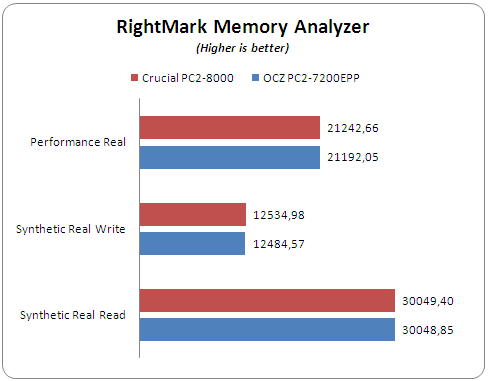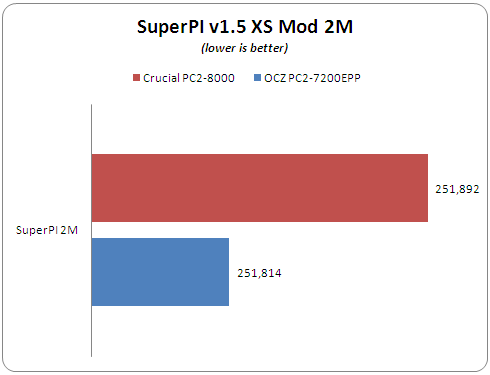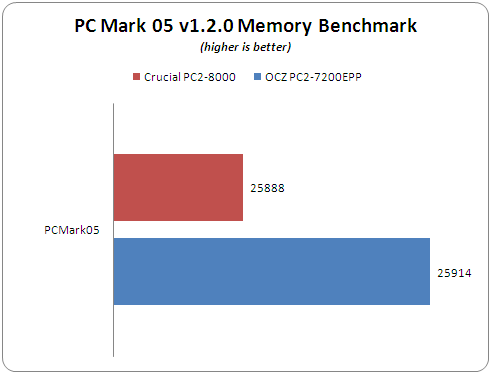1. Introduction
 OCZ Technology Group announced back in April, the PC2-7200 Platinum Series - the introduction of OCZ’s memory line with Enhanced Performance Profiles (EPP). The new PC2-7200 Platinum EPP modules are exclusively designed with advanced SPD settings to allow compatible motherboards to recognize and utilize the added operating data, ultimately increasing the performance potential of the entire platform.
OCZ Technology Group announced back in April, the PC2-7200 Platinum Series - the introduction of OCZ’s memory line with Enhanced Performance Profiles (EPP). The new PC2-7200 Platinum EPP modules are exclusively designed with advanced SPD settings to allow compatible motherboards to recognize and utilize the added operating data, ultimately increasing the performance potential of the entire platform.
The mission of Enhanced Performance Profiles is to offer optimized system operation and compatibility through the collaboration and integration of OCZ configured SPD (Serial Presence Detect) settings and BIOS designs on NVIDIA® nForce® 590 SLI™-based motherboards. Only motherboards equipped with the custom-designed BIOS, such as those designed for NVIDIA nForce 590 SLI MCPs, can detect the optimized SPD profiles of the EPP-based modules and ensure the memory overclocks under the best possible conditions.

When installed on a compatible motherboard, OCZ EPP modules immediately operate at 900MHz DDR2 with 4-4-3 timings without the customary BIOS adjustments, resulting in an innovative and clear-cut method for unacquainted individuals to overclock their system. The PC2-7200 Platinum solutions will be available in 1024MB (1GB) modules and 2GB (2x1024MB) dual channel kits to enhance the latest graphic-intensive PC games, such as Battlefield 2, Half Life 2, Doom 3, and Quake 4, which deliver the best end-user experience with 2GB+ of memory.

All SLI-Ready PC2-7200 Platinum EPP modules are 100% hand-tested for quality assurance and compatibility and feature high quality, platinum-mirrored XTC heatspreaders for the most effective heat dissipation. Furthermore, each OCZ EPP module is backed by the industry leading OCZ Lifetime Warranty and technical support for unparalleled peace of mind. With the fusion of the sophisticated EPP memory specification and cutting-edge, high-speed OCZ DDR2 architecture, the PC2-7200 Platinum edition is the ultimate breakthrough for advanced SLI platform performance.
- Main features
- 900MHz DDR2
- 4-4-3-15
(CAS-TRCD-TRP-TRAS)
- Available in 1GB and 2GB (2x1024) dual channel kit
- Unbuffered
- Platinum Mirrored XTC Heatspreader
- Lifetime Warranty
- 2.1 Volts
- 240 Pin DIMM
- NVIDIA® SLI™ certified
- 2.2V EVP
- Retail package
OCZ Technology provided us with the retail package of the OCZ DDR2 PC2-7200 Platinum SLI (2x1GB). The retail price is around ~US$400 and includes the two memory modules in a protective plastic shell.

We can see the modules removed from their plastic packaging below. On both sides of the heatspreader, there is the "OCZ" logo, while on one side of each there is a sticker with the model and part numbers, and other manufacturing information.


The OCZ PC2-7200EPP have been designed to work at DDR2-900 with CL4-4-3-15, making them very fast. The memory is rated as "EL". EL stands for Enhanced Latency. Enhanced Latency memory modules are specifically designed to run at lower latencies than normally possible with most standard memory modules.

2. Testbed
In order to test the SuperTalent PC2-6400, we used the following setup:
- CPU: Intel XE6600 @ 2.4GHz
- Motherboard: Asus P5B Deluxe Wi-Fi Edition BIOS 0903 (beta)
- PSU: OCZ GameXStream GXS600 SLI-Ready
- VGA: MSI 7600GT Silent (stock memory/core timings)
- HDD: WD 800JB
- OS: Windows XP SP2 with all the latest updates installed
While for benchmarking we used:
- Memtest86+ v1.65
- Sisoft Sandra 2007 SP1
- RightMark Memory Analyzer v3.70
- Pov-Ray v3.7 Beta15
- SuperPI XS Mod v1.50
The Asus P5B Deluxe offers various CPU:RAM ratio locks and high overclocking tuning precision. With CPU-Z, we can check the properties of the memory modules. Strangely, the PC2-7200 were reported as PC2-6400 with EPP technology. At 454MHz its memory timings are 4-4-3-15:

For all tests, we manually set the FSB to 266MHz. This made the CPU run at 2.40GHz and we then used the various built-in CPU:RAM ratios to underclock/overclock the memory:

Each CPU:RAM ratio offers different performance which we benchmarked with our software suite. For each setting, we tried to find the most aggressive timings that offer the best possible performance. Each setting, before benchmarking, had to pass a 30min test with Memtest86+ v1.65 without producing any error in all tests. All benchmarks were doubly confirmed and the displayed results are the average of both measurements.
- Overclocking
The user has to manually set aggressive timings and memory voltages. All tests were carried out at 2.25V, since the Asus P5B Deluxe doesn't offer a 2.20V setting. Below are the best timings we managed to get and the real frequency for each memory speed:

The test results are the most impressive we have seen in our labs. The OCZ PC2-7200EPP managed to reach 1128MHz (564MHz effective), even though its rated as "only" 450MHz. We also had success at 1148MHz but the system was not 100% stable. Maybe with more voltage "juice", you can achieve even higher memory speeds.

3. SiSOFT Sandra - RightMark
 SiSoftware Sandra (the System ANalyser, Diagnostic and Reporting Assistant) is an information & diagnostic utility. It should provide most of the information (including undocumented) you need to know about your hardware, software and other devices whether hardware or software. It works along the lines of other Windows utilities, however it tries to go beyond them and show you more of what's really going on. Giving the user the ability to draw comparisons at both a high and low-level. You can get information about the CPU, chipset, video adapter, ports, printers, sound card, memory, network, Windows internals, AGP, PCI, PCIe, ODBC Connections, USB2, 1394/Firewire, etc.
SiSoftware Sandra (the System ANalyser, Diagnostic and Reporting Assistant) is an information & diagnostic utility. It should provide most of the information (including undocumented) you need to know about your hardware, software and other devices whether hardware or software. It works along the lines of other Windows utilities, however it tries to go beyond them and show you more of what's really going on. Giving the user the ability to draw comparisons at both a high and low-level. You can get information about the CPU, chipset, video adapter, ports, printers, sound card, memory, network, Windows internals, AGP, PCI, PCIe, ODBC Connections, USB2, 1394/Firewire, etc.
Sisoft Sandra offers two types of tests, un-buffered and buffered. Below are the test results.

The results clearly show that the higher the CPU:RAM ratio, the better the performance you get. 1:1 seems a little slow, so if you're thinking of doing any overclocking attempts, you should probably begin with 3:5 (DDR2 889).
 Before this test packet was created there was no proper software for measuring vital system parameters such as CPU/Chipset/RAM providing steady and reliable (reproducible) test results and allowing for changing test parameters in a wide range.
Before this test packet was created there was no proper software for measuring vital system parameters such as CPU/Chipset/RAM providing steady and reliable (reproducible) test results and allowing for changing test parameters in a wide range.
Vital low-level system characteristics include latency and real RAM bandwidth, average/minimal latency of different cache levels and its associativity, real L1-L2 cache bandwidth and TLB levels specs. Besides, these aspects are usually not paid sufficient attention in product technical documentation (CPU or chipset). Such test suite, which combines a good deal of subsets aimed at measuring objective system characteristics, is a must have for estimating crucial objective platform parameters.
RightMark offers a variety of benchmarks, including both read and write performance for synthetic and performance tests:

With the DDR2 1128 setting, you get some very impressive results.
4. Science Mark - SuperPi
Science Mark 2.0 is an attempt to put the truth behind benchmarking. In an attempt to model real world demands and performance, SM2 is a suite of high-performance benchmarks that realistically stress system performance without architectural bias. Science Mark 2.0 is comprised of 7 benchmarks, each of which measures a different aspect of real world system performance.

ScienceMark2 is a benchmark utility that is heavily influenced by memory performance. We can see the significant jump in performance when going from DDR2 667MHz to DDR2 889 for example.
 SuperPI has become an utility to benchmark modern systems. In August 1995, the calculation of pi up to 4,294,960,000 decimal digits was succeeded by using a supercomputer at the University of Tokyo. The program was written by D.Takahashi and he collaborated with Dr. Y.Kanada at the computer center, the University of Tokyo. This record-breaking program was ported to personal computer environment such as Windows NT and Windows 95 and called Super PI.
SuperPI has become an utility to benchmark modern systems. In August 1995, the calculation of pi up to 4,294,960,000 decimal digits was succeeded by using a supercomputer at the University of Tokyo. The program was written by D.Takahashi and he collaborated with Dr. Y.Kanada at the computer center, the University of Tokyo. This record-breaking program was ported to personal computer environment such as Windows NT and Windows 95 and called Super PI.
The software offers up to 32M calculations of PI numbers, for all memory settings we tested only the 2M calculations.

Overclocking our memory up to 1128MHz, resulted in a 6 seconds saving in the SuperPI 2M calculations compared with the DDR2 533 memory setting.
 PCMark®05 is everything you need to reliably and easily measure the performance of your PC and determine its strengths and weaknesses. With PCMark05, you will be able to select the optimal upgrades for your existing PC, or choose the right new PC that fits your specific needs. This easy-to-use product gives you the same tools and knowledge that virtually every professional tester in the industry uses. Below you can see the score from memory subtest.
PCMark®05 is everything you need to reliably and easily measure the performance of your PC and determine its strengths and weaknesses. With PCMark05, you will be able to select the optimal upgrades for your existing PC, or choose the right new PC that fits your specific needs. This easy-to-use product gives you the same tools and knowledge that virtually every professional tester in the industry uses. Below you can see the score from memory subtest.

PC Mark 05 provides several memory tests. The overall score at DDR2 1067MHz is very good.
5. Comparison
Below you can find several scores comparing the Crucial PC2-8000 and OCZ PC2-7200EPP modules. In some benchmarks, Crucial is faster while in others OCZ. Note that the posted results are the sum of all sub-tests at the various CPU:RAM ratios (DDR533/667/800/889/1067MHz).





6. Conclusion
 OCZ Technology is one of the most prominent memory manufacturers. It was among the first to ship a memory product supporting EPP technology. The OCZ PC2-7200 EPP modules are designed with advanced SPD settings to allow compatible motherboards to recognize and utilize the added operating data, ultimately increasing the performance potential of the entire platform. This equates to overclocking capabilities for inexperienced users and gives the highest possible performance. The PC2-7200 Platinum EPP is designed to run at 450MHz, with enhanced latency of 4-4-3-15.
OCZ Technology is one of the most prominent memory manufacturers. It was among the first to ship a memory product supporting EPP technology. The OCZ PC2-7200 EPP modules are designed with advanced SPD settings to allow compatible motherboards to recognize and utilize the added operating data, ultimately increasing the performance potential of the entire platform. This equates to overclocking capabilities for inexperienced users and gives the highest possible performance. The PC2-7200 Platinum EPP is designed to run at 450MHz, with enhanced latency of 4-4-3-15.

According to our tests, the memory reached an impressive 564MHz with voltage up to 2.25V. The overclocking potential is excellent with this memory. You can either select low CL3 latency at DDR2 667 or CL4-4-3-15 (DDR2 889 ratio) and gradually increase FSB up to 381MHz with absolute stability! It's very possible that you can achieve even lower latencies than 4-4-3-15 with increased memory voltage, but that depends on your own setup. We were able to reach 1150MHz with 2.25V. However, our system was not 100% stable, and perhaps with a higher voltage than 2.25V, you can achieve even higher speeds.

 The most exotic feature of these modules is of course EPP technology, which hasn't been tested in our labs...Why? Simply because EPP works only with Nvdia 590SLI enabled motherboards and our standard testbed board for all memory tests is based on the Intel 965Express chipset.
The most exotic feature of these modules is of course EPP technology, which hasn't been tested in our labs...Why? Simply because EPP works only with Nvdia 590SLI enabled motherboards and our standard testbed board for all memory tests is based on the Intel 965Express chipset.
We were so impressed from the overclocking capabilities of these modules, that we believe you won't need to look around at PC2-8000 or PC2-8500 rated memories. The retail price of ~US$400 is higher than what you would pay compared with other PC2-6400 products, but that is outweighed when you look at the performance. Also consider that PC2-8000+ memory modules cost a lot more (US$500+) so you could say it's a bargain :-)
Overall, a highly recommended product, especially for overclockers!